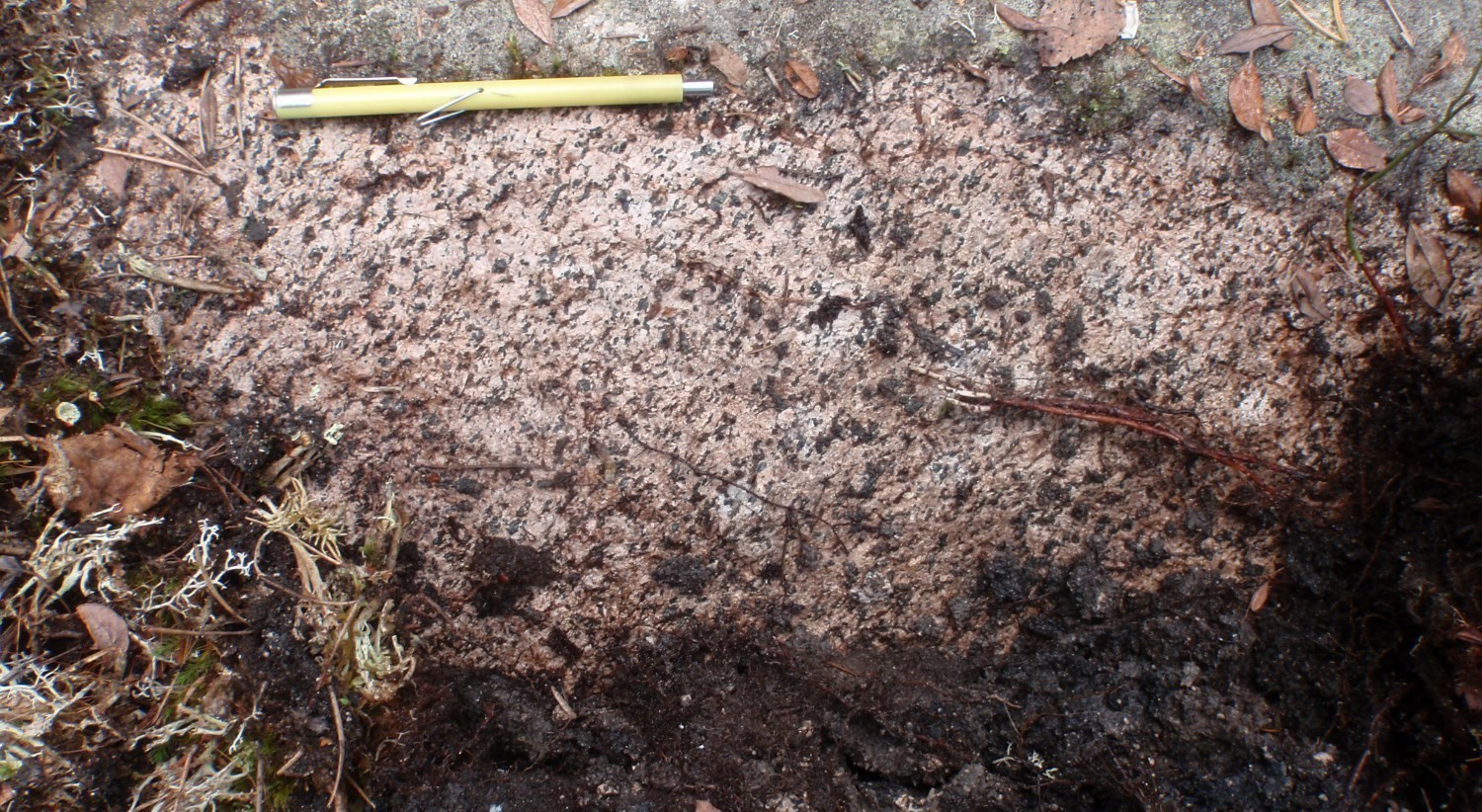
DISCLAIMER: This English version is translated from the original French. In case of any discrepancy, the French version shall prevail.
| Author(s): | Hocq in MER, 1983 |
| Age: | Neoarchean |
| Stratotype: | Perdrix Lake (type locality) |
| Type area: | SE of NTS sheet 32E02 and NE of sheet 32D15 |
| Geological province: | Superior Province |
| Geological subdivision: | Abitibi Subprovince |
| Lithology: | Intermediate intrusive rocks |
| Category: | Lithodemic |
| Rank: | Lithodeme |
| Status: | Formal |
| Use: | Active |
None
Background
Johannes (1918) acknowledged the existence of acidic plutonic rocks at the location of the Lac de la Perdrix Pluton without its name or precise delineation; it was then included in a enormous mass of “acid batholitic intrusive rocks”, including granite, granitic gneiss, granodiorite, diorite, aplite and pegmatite. In 1934, Backman had identified an intrusion whose boundaries more or less coincided with those of today, at least in its southern half; it was part of an undifferentiated group comprising granite, syenite and granodiorite. Ross (1959) traced the northern contact of the intrusion quite accurately and described it as hornblende syenite surrounded by an essentially dioritic rim. Hocq (1981) later described the pluton as a massive biotite-hornblende tonalite unit containing several volcanic and sedimentary rock enclaves.
The name of the unit is first mentioned in the report of Hocq (in MER 1983) as the “Lac de la Perdrix Massif” in reference to Perdrix Lake located in the centre of the intrsion. The current name “Lac de la Perdrix Pluton” appears for the first time in the geological map of NTS sheet 32D15 produced by Beausoleil and Doucet (1998, in MRNF, 2010). According to the 1/250 000 compilation map of the 32E sheet (MRNF, 2010), this puton consists of quartz monzodiorite to monzonite. Deschênes et al. (2014) distinguish two main units: hornblende-clinopyroxene quartz monzodiorite and monzonite (nAper1), and gabbro and pyroxenite (nAper2). However, the existence of the nAper2 unit was based on few observations, leading to its abandonment. Guemache (2020) recognized two units to the Lac de la Perdrix Pluton, which are described below.
Description
The Lac de la Perdrix Pluton is divided into two informal units: the first (nAper1) consists of biotite-hornblende quartz monzonite and quartz monzodiorite, occupies the core of the intrusion and is characterized by low residual magnetic field intensity; the second (nAper2) consists of biotite-hornblende-clinopyroxene ± orthopyronene monzodiorite and monzonite, occupies the edge and some central areas of the intrusion and is distinguished by relatively high magnetic susceptibility.

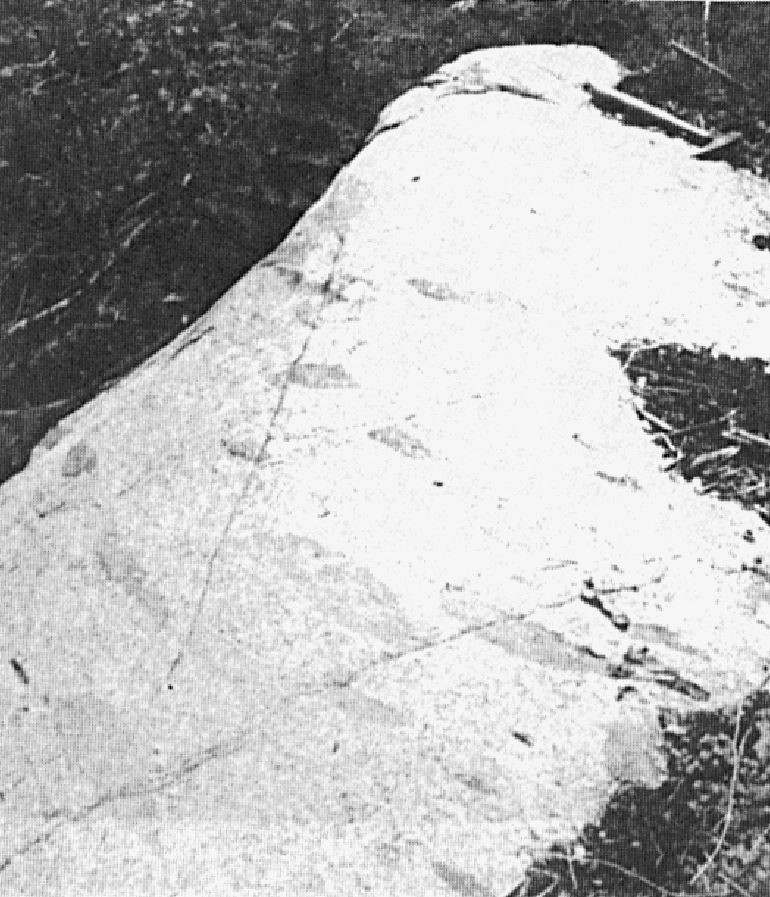
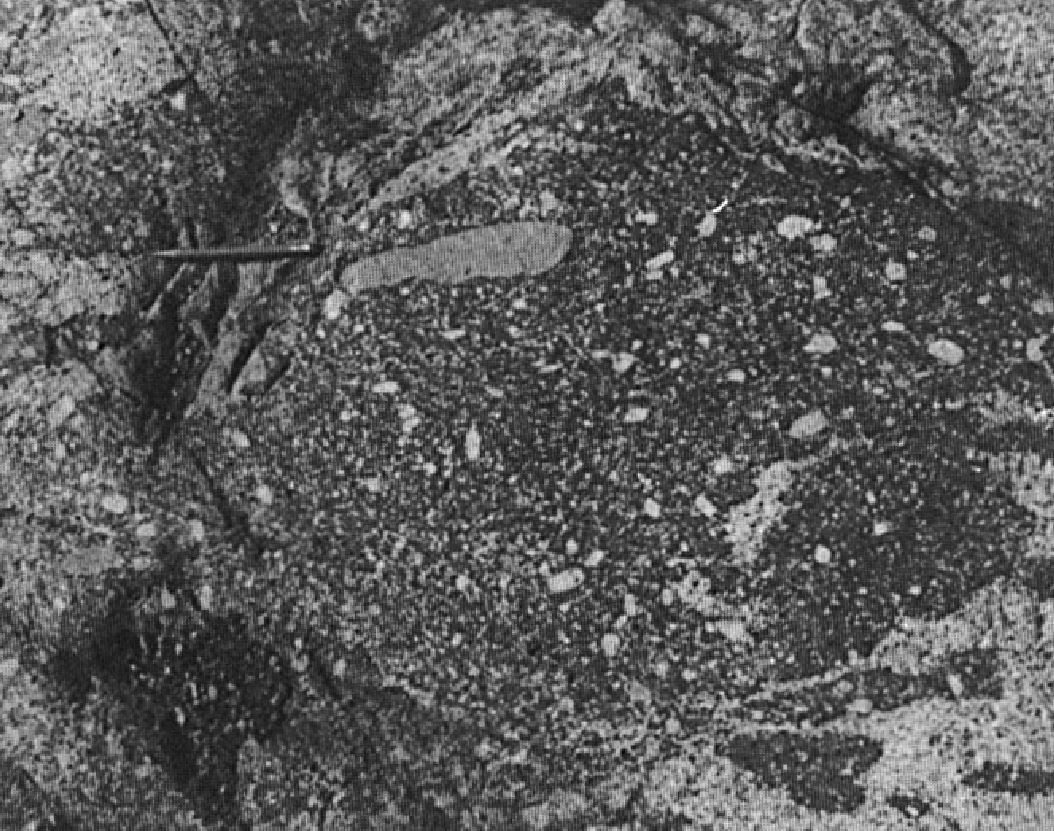 The pluton contains numerous enclaves. According to Hocq (in MER, 1983; pages 243-244): “This intrusion contains frequent enclaves, little or not recrystallized, of mafic rocks (meladiorite, hornblendite), especially in the central and eastern parts of the massif. Numerous mesoscopic lava enclaves located in the contact zone as small ellipsoids or stretched bands a few metres long. These are sprinkled with euhedral feldspar crystals that crystallized during a late metasomatism phase. Some large biotite-garnet gneiss enclaves, arranged parallel to foliation, meet near contact in the eastern part of the intrusion. These enclaves could be the equivalent of tuffs or metamorphosed sediments.” The presence of volcanic rock enclaves in the eastern part of the intrusion was already mentioned in the map of Backman (1934). Several others were also mentioned in recent outcrop descriptions (e.g., outcrop 2012-PL-1032).
The pluton contains numerous enclaves. According to Hocq (in MER, 1983; pages 243-244): “This intrusion contains frequent enclaves, little or not recrystallized, of mafic rocks (meladiorite, hornblendite), especially in the central and eastern parts of the massif. Numerous mesoscopic lava enclaves located in the contact zone as small ellipsoids or stretched bands a few metres long. These are sprinkled with euhedral feldspar crystals that crystallized during a late metasomatism phase. Some large biotite-garnet gneiss enclaves, arranged parallel to foliation, meet near contact in the eastern part of the intrusion. These enclaves could be the equivalent of tuffs or metamorphosed sediments.” The presence of volcanic rock enclaves in the eastern part of the intrusion was already mentioned in the map of Backman (1934). Several others were also mentioned in recent outcrop descriptions (e.g., outcrop 2012-PL-1032).
Lac de la Perdrix Pluton 1 (nAper1): Biotite-Hornblende Quartz Monzonite and Quartz Monzodiorite, Locally K-feldspar Porphyraceous
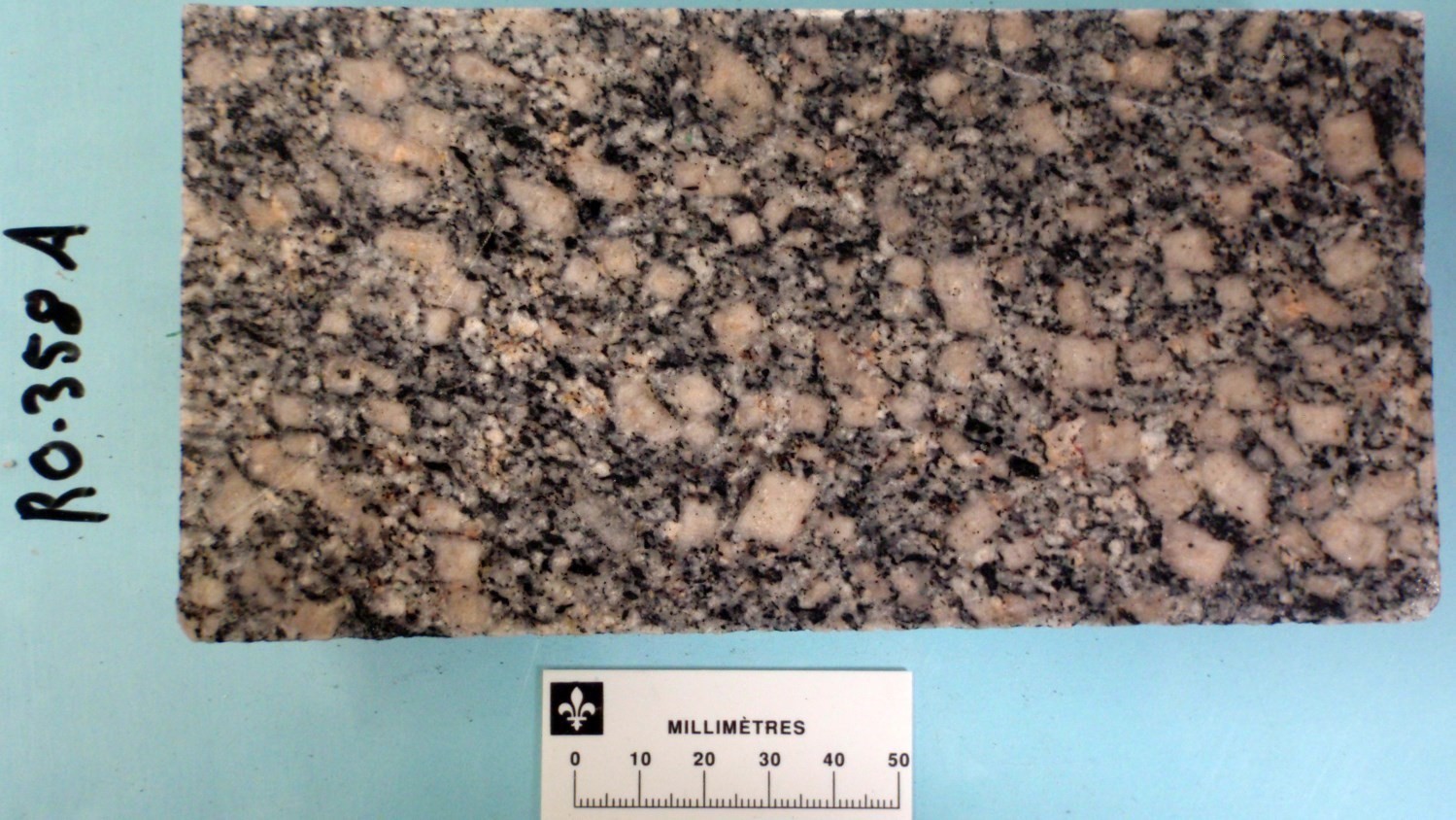 Unit nAper1 consists of pink leucocratic quartz monzonite and quartz monzodiorite, massive, medium or coarse-grained, locally k-feldspar porphyraceous (drillhole RO-358). In thin sections, this unit is composed of quartz (<20%) locally having undulatory extinction, plagioclase more or less sericitized, orthose, and microcline as microperthitic phenocrystals, interstitial crystals or inclusion of small crystals in plagioclase (antiperthite). Biotite (usually <5%) and hornblende (usually <5%) are commonly associated. Accessory minerals are epidote, allanite, titanite, apatite and low amounts of opaque minerals. Quartz and plagioclase commonly form myrmekites.
Unit nAper1 consists of pink leucocratic quartz monzonite and quartz monzodiorite, massive, medium or coarse-grained, locally k-feldspar porphyraceous (drillhole RO-358). In thin sections, this unit is composed of quartz (<20%) locally having undulatory extinction, plagioclase more or less sericitized, orthose, and microcline as microperthitic phenocrystals, interstitial crystals or inclusion of small crystals in plagioclase (antiperthite). Biotite (usually <5%) and hornblende (usually <5%) are commonly associated. Accessory minerals are epidote, allanite, titanite, apatite and low amounts of opaque minerals. Quartz and plagioclase commonly form myrmekites.
Lac de la Perdrix Pluton 2 (nAper2): Biotite-Hornblende-Clinopyroxene ± Orthopyronene Monzodiorite and Monzonite
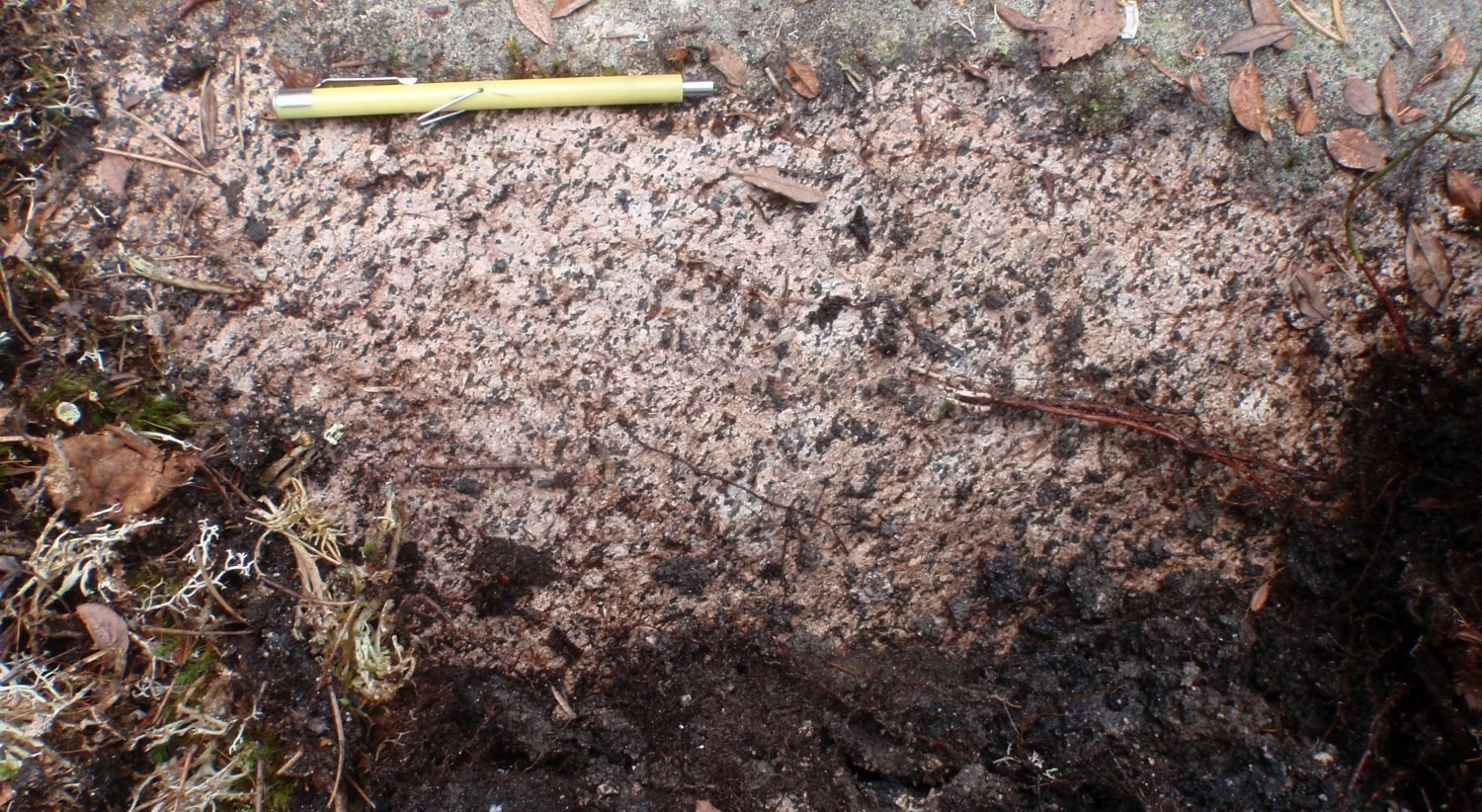 Unit nAper2 is distinguished by relatively high magnetic susceptibility. It consists of massive, medium-grained, greenish grey, mesocratic monzodiorite and monzonite. Ferromagnesian minerals are more abundant (up to 20%) and larger than in unit nAper1. In thin sections, the rock is composed of quartz (<5%), sericitized plagioclase, K-feldspar, slightly chloritized biotite (5-15%) and hornblende (10%) generally having a poikilitic texture. Hornblende also rims clinopyroxene grains (<5%) undergoing urallitization. Accessory minerals are allanite, titanite, apatite and opaque minerals. Chloritized and magnetitized hypersthene (<1%) was observed in a monzonite sample.
Unit nAper2 is distinguished by relatively high magnetic susceptibility. It consists of massive, medium-grained, greenish grey, mesocratic monzodiorite and monzonite. Ferromagnesian minerals are more abundant (up to 20%) and larger than in unit nAper1. In thin sections, the rock is composed of quartz (<5%), sericitized plagioclase, K-feldspar, slightly chloritized biotite (5-15%) and hornblende (10%) generally having a poikilitic texture. Hornblende also rims clinopyroxene grains (<5%) undergoing urallitization. Accessory minerals are allanite, titanite, apatite and opaque minerals. Chloritized and magnetitized hypersthene (<1%) was observed in a monzonite sample.
Thickness and distribution
The Lac de la Perdrix Pluton is found NE of sheet 32D15 and SE of sheet 32E02. Its relatively high magnetic susceptibility relative to host rocks, particularly at the edge, makes it possible to recognize this almost circular intrusion (11 km x 9 km).
Dating
None.
Stratigraphic Relationship(s)
The Lac de la Perdrix Pluton intrudes into the Clermont-Disson Formation, and cut the Glandelet Formation and a dioritic intrusion to the NE. The maximum sedimentation age of the Glandelet Formation is 2695 ±1 Ma (Rhéaume et al., 2010); therefore, the Lac de la Perdrix Pluton would be younger than this age.
Paleontology
Does not apply.
References
Publications Available Through SIGÉOM Examine
DESCHENES, P L., ALLARD, G., GUEMACHE, M A. 2015. REVISION DE LA GEOLOGIE DE LA REGION DE LA RIVIERE WAWAGOSIC (PARTIES DES SNRC 32D15 ET 32E02). MERN. RP 2014-04, 22 pages.
GUEMACHE, M A. 2020. Synthèse géologique de la région de rivière Octave, Abitibi. MERN. RG 2018-01, 68 pages et 1 plan.
HOCQ, M. 1981. CARTE GEOLOGIQUE PRELIMINAIRE DE LA REGION DE JOUTEL – GUYENNE (COMTES D’ABITIBI-EST ET D’ABITIBI-OUEST). MRN. DP 851, 1 plan.
MER. 1983. RAPPORT D’ETAPE DES TRAVAUX EN COURS A LA DIVISION DU PRECAMBRIEN. ET 82-01, 269 pages and 2 plans.
MRNF, 2010. CARTE(S) GÉOLOGIQUE(S) DU SIGEOM – feuillet 32e. CG SIGEOM32E, 57 plans.
RHEAUME, P., MAURICE, C., PARENT, M., MCNICOLL, V. 2010. GEOLOGIE DE LA REGION DE LA RIVIERE BIGNIBA (PARTIES DES SNRC 32F03, 32F04 ET 32C13). MRNF. MB 2010-06, 47 pages and 1 plan.
ROSS, S H. 1959. REGION DE CELORON – CARQUEVILLE, DISTRICTS ELECTORAUX D’ABITIBI-EST ET D’ABITIBI-OUEST. MRN. RG 089, 26 pages and 1 plan.
ROSS, S H. 1959. CELERON – CARQUEVILLE AREA, ABITIBI-EAST AND ABITIBI-WEST ELECTORAL DISTRICTS. MRN. RG 089(A), 25 pages and 1 plan.
Other Publications
BACKMAN, O.L. 1934. Macamic Sheet, Abitibi County, Quebec. Geological survey of Canada; « A » Series Map 298A, 1 sheet. https://doi.org/10.4095/107571
JOANNES, A. 1918. Harricanaw-Turgeon Basin, Abitibi, Timiskaming and Pontiac, Quebec. Geological survey of Canada; « A » Series Map 183A, 1 sheet. https://doi.org/10.4095/107525
Suggested Citation
Ministère de l’Énergie et des Ressources naturelles (MERN). Lac de la Perdrix Pluton. Quebec Stratigraphic Lexicon. gq.mines.gouv.qc.ca/lexique-stratigraphique/province-du-superieur/pluton-du-lac-de-la-perdrix_en [accessed on Day Month Year].
Contributors
|
First publication |
Mehdi A. Guemache, P. Geo., Ph.D. mehdi.guemache@mern.gouv.qc.ca (redaction and coordination) Pierre Lacoste, P. Geo., M.Sc. (critical review); Claude Dion, Eng., M.Sc. (editing); Céline Dupuis, P. Geo., Ph.D. (English version); Yan Carette (HTML editing). |

